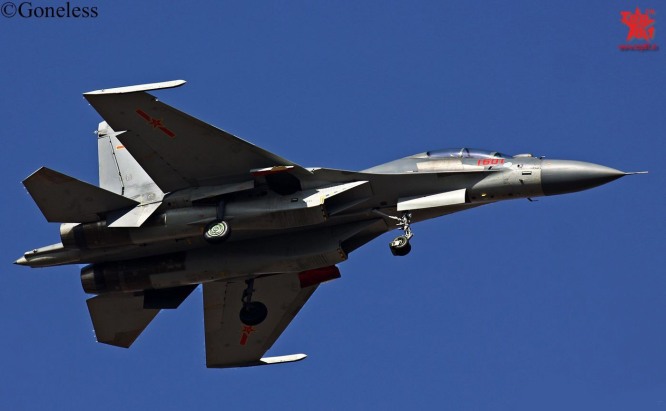
Chinese social media revealed yet another new fighter aircraft development programme currently undergoing flight test. The latest revelation is a Shenyang (SAC)-produced copycat of the Russian Sukhoi Su-30MKK (NATO code name: Flanker-G) two-seater multirole fighter, reportedly designated by the PLAAF as the J-16.
It is now a common knowledge that China has been reverse-engineering the Sukhoi Flanker series fighter aircraft using examples it purchased from Russia in the 1990s. After a short-lived co-production of the basic variant Su-27SK (Flanker-B) known as J-11 between 1998 and 2002, Shenyang Aircraft Corporation (SAC) began to produce an indigenised version known as J-11B in 2004. This was followed by a two-seater variant J-11BS (Su-27UBK Flanker-C) in 2007. In 2009, Shenyang successfully flew the J-15 carrier-based fighter, which was developed by modelling the T-10K, the prototype of the Russian Navy Su-33 (Flanker-D). In recent years, Russia has repeatedly expressed its concerns over the unlicensed copying of Russian fighters by Chinese manufacturer, a key factor that hindered the recent negotiation on the Su-35 (Flanker-E) deal with China. However, this did not seem to have stopped China producing even more Sukhoi-copies, with the J-16 being the latest example.
The Su-30MKK is the first true ‘multirole’ fighter in the Sukhoi Flanker family. China has acquired a total of 100 examples from Russian between 2001 and 2004, including 24 examples in the improved MKK2 variant for its Naval Air Force. The aircraft is equipped with sophisticated electronic countermeasure (ECM) and C4ISR suite for target acquisition and weapon guidance, and is capable of delivering a wide range of air-to-air and air-to-surface weapons. The J-16 is likely going to be equipped with Chinese-made weapon suite, possibly including the PL-12 ‘beyond-visual-range’ MRAAM, the YJ-91 (Kh-31P copy) anti-radiation missile, the YJ-12 supersonic anti-ship missile, the KD-88 TV-/radar-guided air-to-surface missile, and various laser-guided bombs.

The Su-30MKK/J-16 has a combat radius of 1,600 km without requiring aerial refuelling. This is increased to 2,600 km with one refuelling, or 3,500 km with two. This allows the aircraft to reach targets as far as the Java Sea even taking off from inland airfields, or loiter for significant periods over contested areas of the South China Sea. Another distinctive advantage of the aircraft is its sophisticated C4ISR capability, which allows the aircraft to either operate alone, or as an airborne command post for other combat aircraft (as how the Su-30 was originally proposed for the Soviet Air Force).
The J-16 is only one latest example of the booming Chinese military aviation industry, which is running at least five or six fighter aircraft development programmes in both 4thand 5th generation simultaneously. In a world where military budgets are being cut left right and centre everywhere else, development at such a scale is truly unparalleled. However, a closer examination of these programmes suggests that most of these programmes merely to allow the PLA to catch up with its counterparts in Russia and Western world, since similar aircraft have already been in service with these air forces for a decade or more (for example, the Boeing F-15E, widely regarded as a close comparison to the Su-30MKK/J-16, entered service with the USAF in 1988). Nonetheless, the latest developments will no doubt put the PLAAF in the league of the world’s best equipped air forces.http://sinodefence.com/
No comments:
Post a Comment